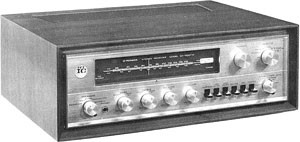The Pioneer SX-1000TW, a solid-state AM/FM receiver from 1971, represents a significant era in audio technology. This vintage piece of audio equipment, part of Pioneer’s esteemed SX series, offers a glimpse into the craftsmanship and sound quality that defined the golden age of hi-fi. While not the flashiest in appearance compared to later Pioneer models, the SX-1000TW delivers a warm, robust audio experience that continues to captivate enthusiasts today.
 Pioneer SX-1000TW Receiver Front View
Pioneer SX-1000TW Receiver Front View
Delving into the Specifications of the SX-1000TW
The Pioneer SX-1000TW specifications highlight its capabilities as a mid-range receiver of its time. It delivers a power output of 50 watts per channel into 8Ω in stereo mode, sufficient for most home listening environments. The frequency response ranges from 20Hz to 50kHz, covering the audible spectrum and beyond. A total harmonic distortion of 0.5% is listed, a typical figure for solid-state receivers of this period. The damping factor is rated at 25, and input sensitivity is specified at 2.4mV for MM phono, 51mV for ceramic, and 200mV for both DIN and line inputs. Signal-to-noise ratios are 80dB for MM phono and 90dB for line inputs, indicating good signal clarity. The receiver accommodates speaker loads from 4Ω to 16Ω. Internally, it utilizes 4 ICs, 1 FET, 42 transistors, and 34 diodes. Physically, the unit measures 405 x 137 x 350mm and weighs 10.6kg.
User Reviews and Sound Performance Insights
User reviews of the Pioneer SX-1000TW on platforms like HiFi Engine offer valuable perspectives on its real-world performance. One reviewer, sonyvfet, initially found the stock receiver to be “crystal clear” but lacking in soundstage. However, after upgrading the speaker output coupling capacitors to ELNA Silmic II, a dramatic improvement was noted, with the soundstage expanding significantly and rivaling upgraded tube amps. This user even preferred the SX-1000TW’s sound over renowned vintage receivers like the Marantz 2270 and Sansui 5000X, praising it as the “best sounding solid-state receiver” they had experienced. Another reviewer, 71451RC, highlighted the “clear, deep sound” of the receiver, especially when paired with Pioneer CS-88a speakers, emphasizing that its 50 watts per channel is more than adequate for a medium-sized listening room. vermontaigne appreciated the SX-1000TW’s ability to deliver a “never-fatiguing sound,” comparing it favorably to other vintage and modern amplifiers in their collection, including a Pioneer SX-727, Marantz MR220, and Yamaha separates. rkgren1 lauded the “strong” tuner and “warm sound” of their unit, noting its solid build quality and conservative, understated aesthetics.
A Historical Niche and Lasting Appeal
While the Pioneer SX-1000TW may have a THD of 0.5%, which is considered relatively higher than some later models, reviewers and enthusiasts argue that this is not audibly significant at typical listening levels. Many consider this receiver a crucial stepping stone in Pioneer’s history, bridging the gap in early solid-state technology and paving the way for their more celebrated models. Its robust construction, warm sound signature, and surprising performance enhancements achievable through simple capacitor upgrades contribute to its enduring appeal in the vintage audio community. For those seeking a vintage receiver with a rich sonic character and a piece of audio history, the Pioneer SX-1000TW presents an attractive option, often available at bargain prices, making it a worthwhile consideration for budget-conscious audiophiles and vintage hi-fi collectors alike.

